I'm a french guy studying Medicine, born and grown up on a tiny island. Also extremely curious about other cultures, notably British and Asian cultures ! I'll post some stuff about my day to day life as a med student, and from time to time you may see thoughts or art stuff...
Don't wanna be here? Send us removal request.
Photo

Church, Ceremony, France 🇫🇷, Memorial by AnYu on EyeEm
2 notes
·
View notes
Photo

A bit off... Trees In The City, Riverbank by AnYu on EyeEm
0 notes
Photo

Animals, Cat, Daydreaming by AnYu on EyeEm
0 notes
Text
Proof of Time Travel
Could time travel exist? Some people believe so. Look at these images and see what you think.

1. The Chinese Swiss Watch. Back in 2008, a 400 year old tomb was opened. Archaeologists were shocked to discover this small watch among the artifacts. The back of the watch is engraved with the word “Swiss”. They have no explanation of how this modern watch came to be in an unopened 400 year old tomb.

2. Charlie Chaplin Cell Phone. Viewers watching the extras section of the 1928 Charlie Chaplin film “The Circus” noted this person seemed to be talking on a cell phone. Others have claimed it was an ear trumpet, a horned device used to help those who were hard of hearing to hear. If that’s true, skeptics argue, who would she be talking to? Why is she laughing and talking if no one is there to hear but herself?

3. 1940s Hipster. This picture was taken at a small opening event in 1941.Time travel enthusiasts were quick to point out how this man stood out. He appears to be wearing a hooded sweatshirt and printed t-shirt, and holding a modern camera.
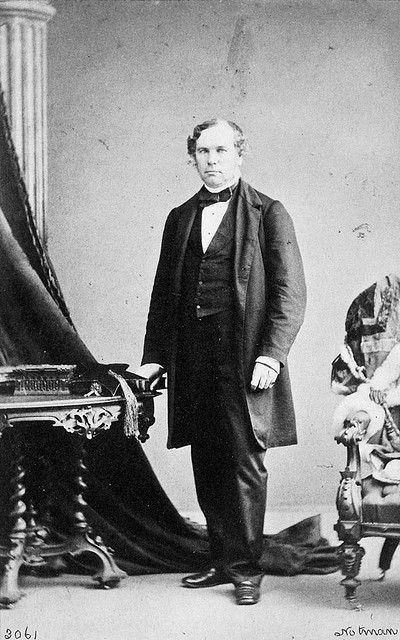
4. Rudolph Fentz. Rudolph apparently vanished without a trace in 1876. That alone wouldn’t be enough to constitute time travel, except that he turned up again…in the 1950s. Fentz allegedly materialized in a New York street, where he was struck by a car and died. Police were baffled as to what happened, especially when they found his pockets to only hold currency from the 1800s.

5. The Man in the Book. A couple was perusing an old book store when they happened across a book with this photograph included. It shows a group from 1917, but this man sticks out. His hair is disheveled and his clothing doesn’t fit in with the time period. Also note how the man beside him his staring at him, as though he too is aware of the strangeness.
324K notes
·
View notes
Photo

Beta-Lactams
Beta-lactams are a wide range of antibiotics, the first of which to be discovered was penicillin, which Alexander Fleming identified in 1928. All beta-lactam antibiotics contain a beta-lactam ring; they include penicillins, such as amoxicillin, and cephalosporins. They work by interfering with the synthesis of peptidoglycan, an important component of the bacterial cell wall, and are mostly used against gram-positive bacteria. Bacteria can, however, develop resistance to beta-lactams via several routes, including the production of enzymes that break down the beta-lactam ring. In the NHS, penicillins are the most commonly prescribed antibiotics, with amoxicillin being the most common in the class.
Sulfonamides
Prontosil, a sulfonamide, was the first commercially available antibiotic, developed in 1932. A significant number of sulfonamide antibiotics were subsequently developed, defined as broad-spectrum antibiotics capable of acting on both Gram-positive and Gram-negative bacteria. Unlike the beta-lactams, they do not act by directly killing the bacteria, but by inhibiting bacterial synthesis of the B vitamin folate, thus preventing growth and reproduction of the bacteria. In the present day, sulfonamides are rarely used, partially due to the development of bacterial resistance, but also due to concern about unwanted effects such as hepatotoxicity.
Aminoglycosides
Aminoglycosides inhibit the synthesis of proteins in bacteria, eventually leading to cell death. They are only effective against certain Gram-negative bacteria, as well as some Gram-positive bacteria, but are not absorbed during digestion, so must be injected. In the treatment of tuberculosis, streptomycin was the first drug found to be effective; however, due to issues with toxicity of aminoglycosides, their present day use is limited.
Tetracyclines
Tetracyclines are broad-spectrum antibiotics, active against both Gram-positive and Gram-negative bacteria. Like the sulfonamides, they inhibit protein synthesis, inhibiting growth and reproduction of bacteria. Their use is decreasing to increasing instances of bacterial resistance; however, they still find use in treatment of acne, urinary tract, and respiratory tract infections, as well as chlamydia infections. They must be taken in isolation, often two hours before or after eating, as they can easily bind with food, reducing their absorption.
Chloramphenicol
Another broad-spectrum antibiotic, chloramphenicol also acts by inhibiting protein synthesis, and thus growth and reproduction of bacteria. However, it is also bactericidal against a limited number of bacteria. Due to the possibility of serious toxic effects, in developed countries it is generally only used in cases where infections are deemed to be life-threatening, although it is also occasionally used in the treatment of eye infections. Despite this, it is a much more common antibiotic in developing countries due to its low cost and availability, and is recommended by the World Health Organisation as an effective first line treatment for meningitis in those countries with a low income.
Macrolides
Much like the beta-lactams, the macrolides are mainly effective against Gram-positive bacteria; however, they act in a bacteriostatic manner, preventing growth and reproduction by inhibiting protein synthesis. Their effectiveness is marginally broader than that of penicillins, and they have been shown to be effective against several species of bacteria that penicillins are not. Whilst some bacterial species have developed resistance to macrolides, they are still the second most commonly prescribed antibiotics in the NHS, with erythromycin being the most commonly prescribed in the class.
Glycopeptides
Glycopeptides include the drug vancomycin – commonly used as a ‘drug of last resort’, when other antibiotics have failed. Whilst this used to be the last line of defence against infections, particularly MRSA, the more recent development of newer antibiotics in other classes has provided other options. Nonetheless, there remain strict guidelines on the circumstances in which vancomycin can be used to treat infections, in order to delay the development of resistance. The bacteria against which glycopeptides are active are otherwise somewhat limited, and in most they inhibit growth and reproduction rather than killing bacteria directly.
Oxazolidinones
Oxazolidinones are active against Gram-positive bacteria, and act by inhibiting protein synthesis, and hence growth and reproduction. Linezolid, approved for use in 2000, was the first marketed antibiotic in the class, although the compound cycloserine has been used as a second line tuberculosis treatment since 1956. Whilst linezolid is expensive, resistance seems to be developing relatively slowly since its introduction.
Ansamycins
This class of antibiotics are effective against Gram-positive bacteria, as well as some Gram-negative bacteria. They inhibit the production of RNA, which has important biological roles inside the cells of the bacteria, and as such leads to the death of the bacterial cells. A subclass of antibiotics, rifamycins, are used to treat tuberculosis and leprosy. Uncommonly, ansamycins can also demonstrate anti-viral activity.
Quinolones
Quinolones are bactericidal compounds that interfere with the replication and transcription of DNA in bacteria cells. They are broad-spectrum antibiotics, and are widely used for urinary tract infections, as well as other hospital-acquired infections where resistance to older classes of antibiotics is suspected. Additionally, their use for veterinary purposes is widespread; a use that has been criticised in some quarters for hastening the development of resistance. Resistance to quinolones can be particularly rapid in its development; in the US, they were the most commonly prescribed antibiotics in 2002, and their prescription for unrecommended conditions or viral infections is also thought to be a significant contributor to the development of resistance.
Streptogramins
Streptogramins are unusual in that they are usually administered as a combination of two antibiotic drugs from the different groups within the class: streptogramin A and streptogramin B. On their own, these compounds only show growth-inhibiting activity, but combined they have a synergistic effect and are capable of directly killing bacteria cells, by inhibiting the synthesis of proteins. They are often used to treat resistant infections, although resistance to the streptogramins themselves has also developed.
Lipopeptides
Discovered in 1987, lipopeptides are the most recent class of antibiotics, and are bactericidal against Gram-positive bacteria. Daptomycin is the most commonly used member of the class; it has a unique mechanism of action, disrupting several aspects of cell membrane function in bacteria. This unique mechanism of action also seems to be advantageous in that, currently, incidences of resistance to the drug seem to be rare – though they have been reported. It is given via injection, and commonly used to treat infections in the skin and tissue.
Antibiotic Resistance
Bacterial resistance to antibiotics is on the rise, to the extent that it has been made the focus of this year’s Longitude Prize. The prize is offering a £10 million prize fund for the development of a cheap and easy to use bacterial infection test kit, in the hope that this will allow doctors to prescribe the correct antibiotics at the correct time for patients, and also prevent the prescribing of antibiotics in the cases of viral infections. It’s hoped both of these measures will help slow the development of antibiotic resistance in bacteria.
SOURCE : CompoundChem
1K notes
·
View notes
Video
vine
#NSFfunded study finds marine animal colony is a multi-jet swimming machine: http://bit.ly/1EwkRCj #bioinspiration
1K notes
·
View notes
Photo





Snatti - https://www.facebook.com/atey.ghailan - snatti89 - http://blog.sina.com.cn/snatti - Atey Ghailan - https://www.artstation.com/artist/Snatti
12K notes
·
View notes
Photo

X-ray image of a pregnant cat with six kittens.
53K notes
·
View notes
Photo





syuka-taupe - Taupe Syuka - taupesyuka - 朱華
7K notes
·
View notes
Photo



Most people know that throwing water into hot oil is a bad idea. But, as dramatic as the results can be, the boiling of a water droplet submerged in oil is remarkably beautiful, as seen in the animations above. The initial water droplet expands as it shifts from liquid to vapor (top). At a critical volume, the expansion occurs explosively (middle), causing the bubble to overexpand relative to the pressure of the surrounding fluid. The higher pressure of the oil around it collapses the drop, which then re-expands, creating the cycle we see in the final two animations. This oscillation triggers a Rayleigh-Taylor type instability along the bubble’s interface, causing the surface corrugations observed. The vapor bubble will continue to rise through the oil, eventually breaking the surface and scattering hot oil droplets. (Image credits: R. Zenit, source)
892 notes
·
View notes
Photo

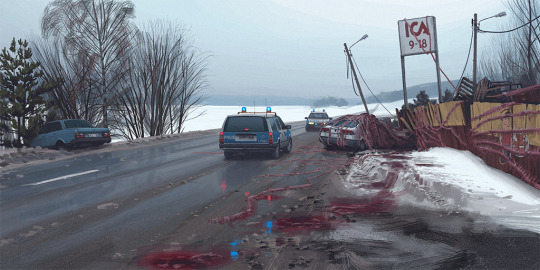

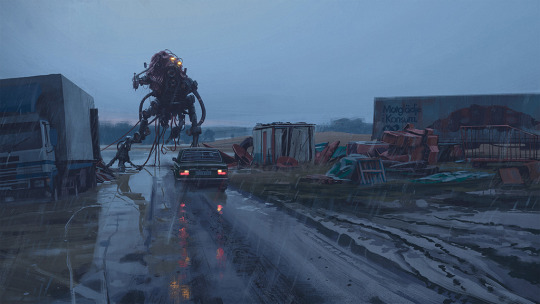




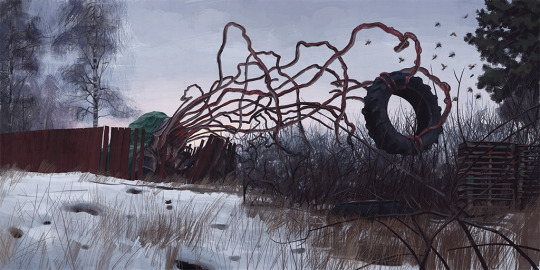

Things From The Flood Part II From www.simonstalenhag.se
39K notes
·
View notes
Photo
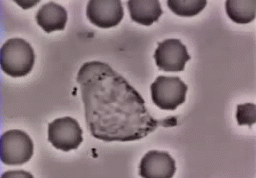

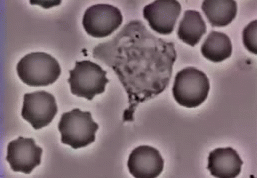
The following is a white blood cell chasing a bacterium. It eventually ends up swallowing it. The following white blood cell is specifically a neutrophil. They end up ingesting the microbe a process known as phagocytosis.
VIDEO
17K notes
·
View notes
Photo


Schlieren optical systems have been used to visualize shock waves in labs for more than a century, but the technique did not translate well to photographing shock structures outside the lab. But now NASA’s Armstrong Research Center and Ames Research Center have developed a method that allows them to capture highly-detailed images of the shock waves around airplanes while they are flying. This is incredible stuff. Be sure to check out the high-resolution versions on this page, along with more description of the coordination necessary to pull off the photos.
The light and dark lines you see emanating from the airplane are places with strong density gradients. The dark lines are mostly shock waves, with the strongest shock waves appearing black due to the large change in air density. Many of the light streaks are expansion fans, areas where the density and pressure drop as air speeds up.
The goal of this research is to better understand shock wave structures around supersonic planes in order to reduce the noise supersonic aircraft cause when flying overhead. As you can see in the photos, the shock waves at the nose and tail of the aircraft persist far away from the aircraft; these are what cause the twin sonic boom heard when the plane flies by. (Photo credit: NASA; via J. Hertzberg)
372 notes
·
View notes
Photo


Daily Paint #1014. Tribute to my favourite GIF by Cryptid-Creations
(GIF Source: https://imgur.com/gallery/Oy3Wz)
Time-lapse, high-res and WIP sketches of my art available on Patreon (:
3K notes
·
View notes



























